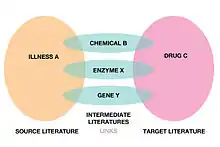Literature-based discovery
Literature-based discovery is a form of knowledge extraction and automated hypothesis generation that uses papers and other academic publications (the "literature") to find new relationships between existing knowledge (the "discovery"). The technique was pioneered by Don R. Swanson in the 1980s and has since seen widespread use.
Literature-based discovery does not generate new knowledge through laboratory experiments, as is customary for empirical sciences. Instead it seeks to connect existing knowledge from empirical results by bringing to light relationships that are implicated and "neglected".[1] It is marked by empiricism and rationalism in concert or consilience.
The evaluation of literature-based discoveries is challenging, and includes both experimental and in silico methods.[2]
Swanson linking

Swanson linking is a term proposed in 2003[3] that refers to connecting two pieces of knowledge previously thought to be unrelated.[4] For example, it may be known that illness A is caused by chemical B, and that drug C is known to reduce the amount of chemical B in the body. However, because the respective articles were published separately from one another (called "disjoint data"), the relationship between illness A and drug C may be unknown. Swanson linking aims to find these relationships and report them.
References
- Chen, Ran; Hongfei Lin & Zhihao Yang (2011). "Passage retrieval based hidden knowledge discovery from biomedical literature." Expert Systems with Applications: An International Journal (August, 2011), vol. 38, no. 8, pp. 9958–9964.
- Abstract: [...] automatic extraction of the implicit biological relationship from biomedical literature contributes to building the biomedical hypothesis that can be explored further experimentally. This paper presents a passage retrieval based method which can explore the hidden connection from MEDLINE records. [...] Experimental results show this method can significantly improve the hidden knowledge discovery performance. @ ACM DL
- Further readings
- Wilson, Patrick (1977). Public Knowledge, Private Ignorance: Toward a Library and Information Policy. Greenwood Publishing Group. p. 156. ISBN 0-8371-9485-7.
- Footnotes
- Swanson, Don (1988). "Migraine and Magnesium: Eleven Neglected Connections". Perspectives in Biology and Medicine. 31 (4): 526–557. doi:10.1353/pbm.1988.0009. PMID 3075738.
- Henry, M. S. Sam; McInnes, Bridget T. (2017-08-21). "Literature Based Discovery: models, methods, and trends". Journal of Biomedical Informatics. doi:10.1016/J.JBI.2017.08.011.
- Stegmann J, Grohmann G. Hypothesis generation guided by co-word clustering. Scientometrics. 2003;56:111–135. As quoted by Bekhuis
- Bekhuis, Tanja (2006). "Conceptual biology, hypothesis discovery, and text mining: Swanson's legacy". Biomedical Digital Libraries. 3: 2. doi:10.1186/1742-5581-3-2. PMC 1459187. PMID 16584552.